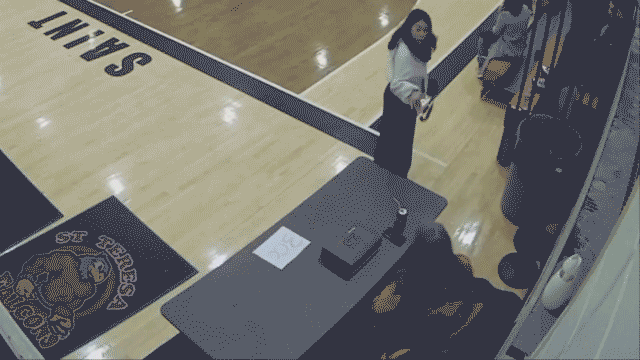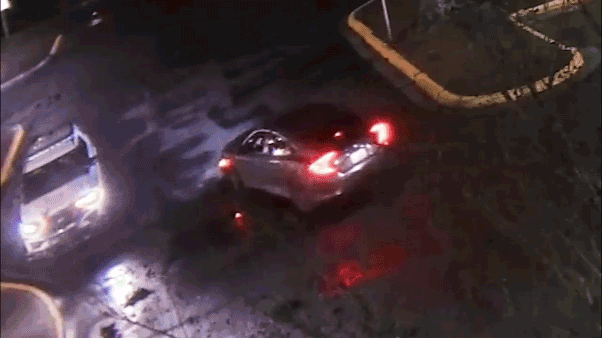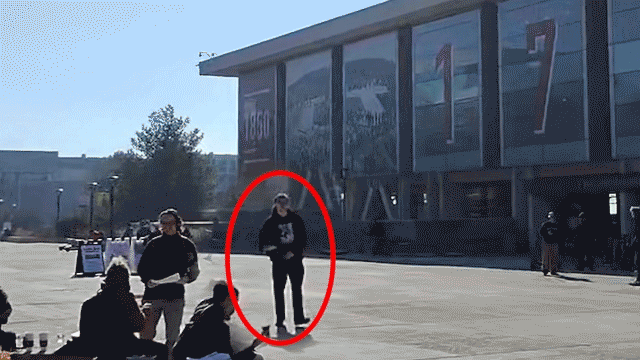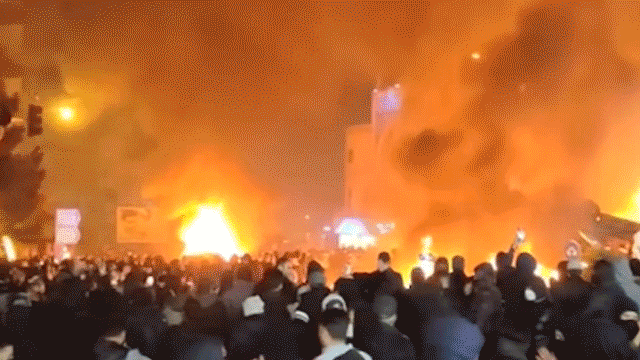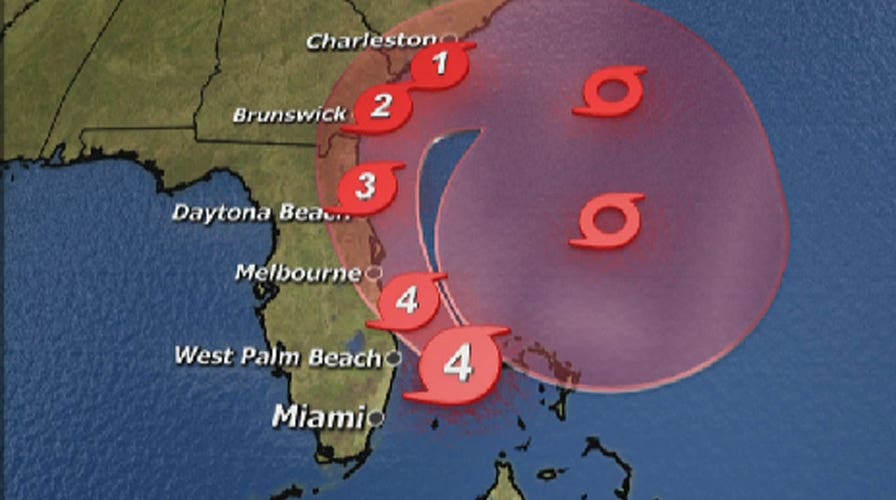Hurricane Matthew nears Florida as category 4 storm
Steve Harrigan reports from Vero Beach, Florida
Hurricane Matthew closed in on Florida Thursday evening as a powerful Category 4 storm as the governor urged people up and down the state's 580-mile Atlantic coastline to brace for "devastating impacts."
"This storm is a monster," Gov. Rick Scott said at an evening news conference. "Matthew is likely to produce devastating impacts along portions of the east coast tonight," he added.
As it moved north in the evening, Matthew stayed about 100 miles or more off South Florida, sparing the 4.4 million people in the Miami and Fort Lauderdale areas from its most punishing effects.
"We were lucky this time," Miami-Dade Mayor Carlos Gimenez said.
By Thursday night, more than 60,000 homes and businesses were without power. Streets in Vero Beach were partially covered with water, and hotel guests in Orlando were told to stay inside, though a few sneaked out to smoke or watch the rain.
The hurricane was instead expected to blow ashore -- or come dangerously close to doing so -- early Friday north of West Palm Beach, which has about 1.1 million people, and then slowly push north for the next 12 hours along the Interstate 95 corridor, through Cape Canaveral and Jacksonville, according to the National Hurricane Center.
Forecasters said it would then probably hug the coast of Georgia and South Carolina over the weekend before veering out to sea -- perhaps even looping back toward Florida in the middle of next week as a tropical storm.
As of 10 p.m. EDT, Matthew was located 65 miles east-southeast of West Palm Beach, moving northwest at about 13 mph.
As evening fell, the winds picked up along Vero Beach, midway between West Palm Beach and Cape Canaveral, stripping away palm fronds, ripping awnings and blowing sand that stung the face. Waves crashed on the beach, and rain came in short bursts. About 30,000 homes and businesses were in the dark.
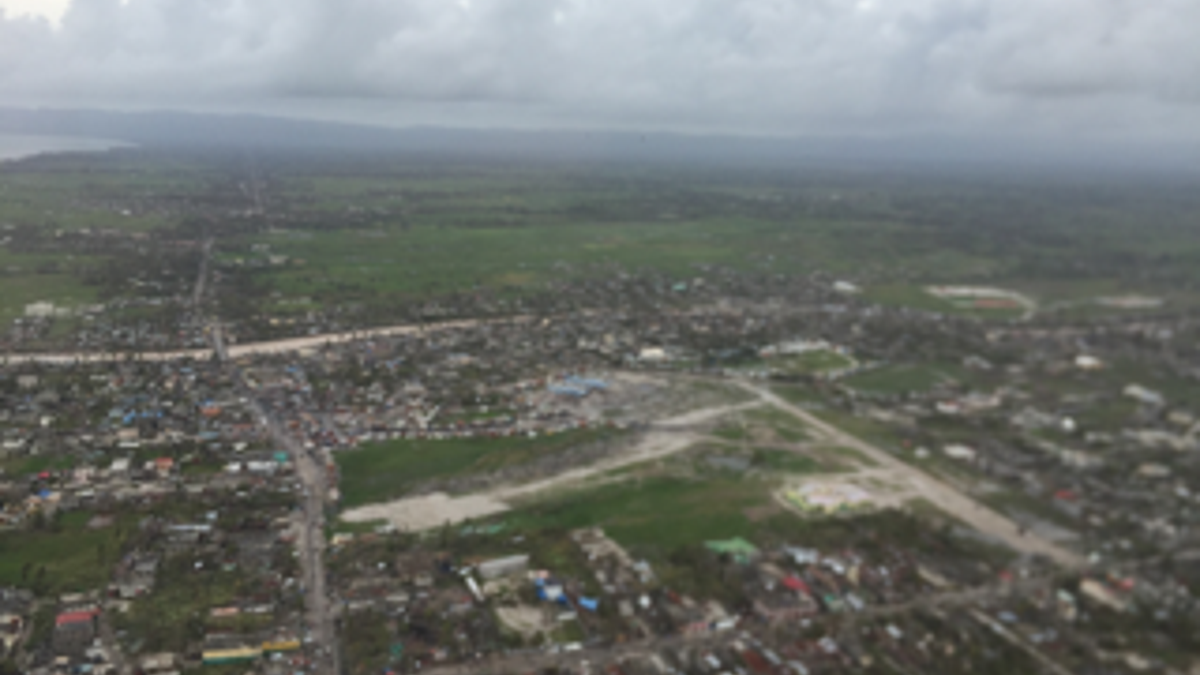
Hurricane damage in Les Cayes, Haiti. (Margaret Traub/International Medical Corps)
Officials from Florida to South Carolina urged an estimated 2 million people to evacuate. Scott said so far he has activated 3,500 Florida National Guard members to assist in any rescues and recovery missions after the storm passed.
CLICK FOR INFORMATION ON CURRENT FLORIDA EVACUATION ORDERS
President Obama declared a state of emergency for Florida and South Carolina on Thursday, clearing the way for federal aid in addition to state and local emergency response teams. The Pentagon reported the governors of Florida, Georgia and South Carolina had mobilized 4,500 National Guardsmen ahead of the hurricane.
Forecasters said Matthew could dump up to 15 inches of rain in some spots and cause a storm surge of 9 feet or more.
They said the major threat to the Southeast would not be the winds -- which newer buildings can withstand -- but the massive surge of seawater that could wash over coastal communities along a 500-mile stretch from South Florida to the Charleston, S.C., area.
The Fort Lauderdale airport shut down on Thursday morning, and further north the Orlando airport also closed. By early-evening, flight-tracking service FlightAware.com reported that nearly 1,500 flights within the U.S. had been scrapped, with the largest numbers at Fort Lauderdale and Miami. American Airlines, which has a major hub in Miami, was the hardest-hit carrier, followed by Southwest Airlines and JetBlue Airways.
Amtrak suspended train service between Miami and New York, and cruise lines rerouted ships to avoid the storm, which in some cases will mean more days at sea.
Workers transferred patients from two Florida waterfront hospitals and a nursing home near Daytona Beach to safer locations. Officials at Walt Disney World, Universal Studios and SeaWorld said the parks would shut down Thursday afternoon until the storm passes.
Thousands of people hunkered down in schools converted to shelters, and inland hotels in places such as Charlotte, N.C., reported brisk business.
At the Kennedy Space Center in Cape Canaveral, NASA no longer has to worry about rolling space shuttles back from the launch pad to the hangar because of hurricanes, since the shuttle fleet is now retired. But the spaceflight company SpaceX was concerned about the storm's effect on its leased seaside pad.
"When a hurricane is forecast to take a track roughly parallel to a coastline, as Matthew is forecast to do from Florida through South Carolina, it becomes very difficult to specify impacts at any one location," National Hurricane Center forecaster Lixion Avila said.
The number of people killed in Haiti rose to at least 283, local officials told Reuters on Thursday, saying the storm killed at least four people elsewhere in the Caribbean.
Georgia Gov. Nathan Deal ordered an evacuation of the state's entire coast, covering more than a half-million people. It was the first hurricane evacuation along the Georgia coast since 1999, when the state narrowly escaped Floyd.
The last Category 3 storm or higher to hit the U.S. was Wilma in October 2005. It sliced across Florida with 120 mph winds, killing five people and causing an estimated $21 billion in damage.
As people hurried to higher ground, authorities in South Carolina said a motorist died on Wednesday after being shot by deputies in a gun battle that erupted when he sped away from a checkpoint along an evacuation route.
South Carolina Gov. Nikki Haley reversed Interstate 26 so that all lanes of traffic were headed west and out of Charleston. It was the first time the lanes had been reversed. Plans to reverse the lanes were put in place after hours-long traffic jams during Hurricane Floyd in 1999.
Haley said Thursday night she's "begging" people to understand the seriousness of Matthew and evacuate the South Carolina coast.
Haley said so far 280,000 people had evacuated as of 3 p.m. Thursday, but that means hundreds of thousands more need to leave.
The governor told reporters that forecasts are getting worse, but "we can't take you by the hand and bring you to the Upstate."
Medical facilities that have had to evacuate their patients include Beaufort Memorial Hospital. Haley said Thursday night that should be an indication of the seriousness.
Authorities said the storm surge in some areas along the southern coast of South Carolina will exceed those when Hurricane Hugo hit the state in 1989. Haley said to "imagine floor-to-ceiling" storm surges, while eastern parts of the state could see 8 to 14 inches of rain.
In Florida, Scott also lifted tolls on major roads. The Florida Turnpike, Alligator Alley and part of the Central Florida Expressway Authority and the Miami-Dade Expressway Authority had toll services suspended, according to Fox 35 Orlando.
In Melbourne Beach, near the Kennedy Space Center, Carlos and April Medina moved their paddle board and kayak inside the garage and took pictures off the walls of their home about 500 feet from the coast. They moved the pool furniture inside, turned off the water, disconnected all electrical appliances and emptied their refrigerator.
They then hopped in a truck filled with legal documents, jewelry and a decorative carved shell that had once belonged to April Medina's great-grandfather and headed west to Orlando, where they planned to ride out the storm with their daughter's family.
"The way we see it, if it maintains its current path, we get tropical storm-strength winds. If it makes a little shift to the left, it could be a Category 2 or 3 and I don't want to be anywhere near it," Carlos Medina said. "We are just being a little safe, a little bit more cautious."
About 20 miles away in the town of Cape Canaveral, John Long said Hurricane Matthew is just hype as his neighbors in his RV park packed up and evacuated inland. Even though his 32-foot RV is just feet from the Banana River and a half mile from the beach, he had no plans to leave.
Long, who owns a bike shop and has lived along the Space Coast for 30 years, said he has a generator and enough food and water for himself and his cats to last a week. "There's always tremendous buildup and then it's no stronger than an afternoon thunderstorm," he said. "I'm not anticipating that much damage."
At Folly Beach, S.C., southwest of Charleston, Gaby Trompeter loaded her car at her beachfront home preparing to evacuate to Augusta, Georgia.
Trompeter, a 50-year-old goldsmith who designs and makes jewelry, remembers Hurricane Hugo when she stayed in Savannah, Georgia, in 1989.
A year ago when what has been described as a 1,000-year flood inundated South Carolina there was so much water on the road near her house she couldn't get out for three days.
"If it brings a lot of rain, more than the storm last year, why would I want to stay?" she said.
On the Georgia coast, 92-year-old Lou Arcangeli saw two of his adult children come to his home on Tybee Island to help prepare and evacuate if necessary.
"It's serious," said Arcangeli, who has lived in the Savannah area since 1979, when Hurricane David became the last hurricane to make landfall on Georgia's 100-mile coast. "I'm going to keep an eye on it and not wait until the last minute. As far as I'm concerned, what's going to happen is going to happen."
"We have a house that sits right here on the water and we kind of said goodbye to it thinking that, you know, the house ... might not be here when we get back," said Jennifer Banker, a resident of Georgia's dangerously exposed St. Simons Island. "You know, we pray a lot and trust God to provide."
Some coastal residents in Georgia and beyond decided to take their chances and stay.
Darcy O'Connor, a restaurant owner who lives in a rowhouse in Savannah, Ga., a historic city of many beautifully maintained homes from the 18th and 19th century, said she and her most of her neighbors were sticking around.
O'Connor noted that her home, built in 1883, has weathered hurricanes before: "Half the windows, if you look, still have the original glass. So that tells you something."
Farmers in Matthew's path scrambled to protect their crops. In South Carolina, Jeremy Cannon was harvesting his soybeans a week early after waiting too long before last year's record rainstorm. He watched his soybeans and cotton crops slowly drown as 20 inches of rain fell, costing him $800,000.
"I don't want to lose a single soybean this year if I don't have to," Cannon said. "The Lord says pray without ceasing. And that's what I've been doing — in the fields, near the barn — just praying all the time. I don't want to find out what I'll have to do if I get wiped out for another year."
Fox News' Kathleen Foster, Lucas Tomlinson and The Associated Press contributed to this report.
